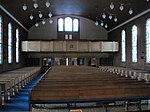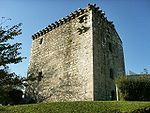Waterfoot, East Renfrewshire

Waterfoot (Scots: Watterfit) is a village in East Renfrewshire, Scotland. It is on the B767 road between Clarkston and Eaglesham, which are 1 mile (1.6 km) to the north and south respectively, while Newton Mearns is about 2 miles (3 km) to the west and East Kilbride about 5 miles (8 km) to the southeast. The village shares a community council with the neighbouring community of Eaglesham, the Eaglesham and Waterfoot Community Council meets in Eaglesham on a monthly basis.During the Second World War, deputy leader of the Nazi party Rudolf Hess, crash landed in Floors Farm, west of the village. He was arrested and held in custody until after the war, when he was tried at the Nuremberg trials. The audio equipment manufacturer Linn Products has its factory to the southwest of Waterfoot.
Excerpt from the Wikipedia article Waterfoot, East Renfrewshire (License: CC BY-SA 3.0, Authors, Images).Waterfoot, East Renfrewshire
Craighlaw Avenue,
Geographical coordinates (GPS) Address Nearby Places Show on map
Geographical coordinates (GPS)
| Latitude | Longitude |
|---|---|
| N 55.764 ° | E -4.283 ° |
Address
Craighlaw Avenue
Craighlaw Avenue
G76 0EX , Kirkhill
Scotland, United Kingdom
Open on Google Maps








